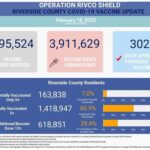The Ebola virus has not been found in California, stressed the state’s highest public health officials last week. “There are no cases of Ebola or suspected cases in California,” said Dr. Ron Chapman, director of the California Department of Public Health, on Wednesday, Oct. 15.
However, on Monday, Oct. 20, as concerns and some fears have grown in the past week, Riverside County health officials created a website to address questions about the virus. The website, www.rivcoph.org/Ebola.aspx, will house information from the Riverside County Department of Public Health, California Department of Public Health, Centers for Disease Control and Prevention and other reliable sources to give the public and health providers the latest updates on Ebola and what is being done to prevent the virus’ spread.
Nevertheless, they are prepared and still preparing in case a patient may be identified in California. Over the past week, officials have held conference calls with hospitals, doctors, nurses and other first responders throughout the state.
They have stressed that local health officials look at hospital readiness and capacity. Hospitals throughout Riverside County were conducting these examines all of last week.
Nurses in California and the country are concerned about adequate and appropriate safety when caring for Ebola patients. Gov. Jerry Brown met with leaders of the California Nurses Association and the National Nurses United in Sacramento last week. They discussed ways to make California the national leader in enacting the highest Ebola safety standards and protocols to protect nurses, other frontline health care workers, patients and the public.
The discovery of a second health-care worker with Ebola in Texas escalated the fear of the virus spreading throughout the nation. Two different surveys found the fear of the virus growing. On Thursday, airline stocks declined sharply due to fears of a decline in flying.
While two possible Ebola victims were identified in California last week, tests for the virus came back negative, state officials said in a Wednesday teleconference.
“But it would not be unexpected for California to have a confirmed case of Ebola, therefore we need to be prepared to respond promptly and carefully,” advised Dr. Gil Chavez, deputy director of CDPH’s Center for Infectious Diseases. “But Ebola does not pose a significant public health risk to communities in California at the present time.”
One of the steps state officials have initiated is working with the federal government to screen possible infected individuals arriving in California at one of the state’s international airports.
“California is an important destination for many travelers. We believe our international airports in the state have potential for exposure,” Chavez said, explaining why the state was urging screening for some state airports.
In a Kaiser Health Policy survey, nearly two out of three Americans said they were very closely or fairly closely following the news about the Ebola outbreak. Nearly 90 percent are aware of at least one case in the United States.
In a Harvard School of Public Health survey, more than half of the respondents were concerned that an Ebola outbreak might occur in the U.S during the next year.
While 97 percent of the public knows the disease is spread through direct contact with the blood or body fluids of a person who is sick with Ebola or showing symptoms, two-thirds believe it can be transmitted through the air and more than half think shaking hands is sufficient to transfer the virus. Eighty-five percent of the respondents in the Harvard survey thought it was likely that a sneeze or cough could spread the virus.
“Current scientific evidence testifies that people cannot get Ebola through the air, food or water,” Chavez stressed. “Ebola virus does not survive more than a few hours on surfaces.”
And Dr. James Watts, director of the Division of Communicable Disease Control, stressed, “Patients are not contagious when they are not symptomatic.”
Only about one in five Americans believe there has been too much coverage of the disease and slightly less feel there has been too little media coverage.










